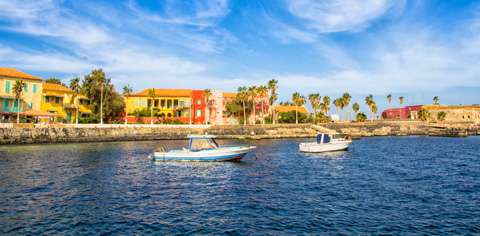How much does it cost to travel to Dakar?
You should plan to spend around $62 (CFA37,328) per day on your vacation in Dakar. This is the average daily price based on the expenses of other visitors.
Past travelers have spent, on average for one day:
- $20 (CFA11,966) on meals
- $5.41 (CFA3,269) on local transportation
- $65 (CFA39,478) on hotels
A one week trip to Dakar for two people costs, on average, $864 (CFA522,596). This includes accommodation, food, local transportation, and sightseeing.
All of these average travel prices have been collected from other travelers to help you plan your own travel budget.
Independent Travel
Traveling Independently to Dakar has many benefits including affordabilty, freedom, flexibility, and the opportunity to control your own experiences.
All of the travel costs below are based on the experiences of other independent travelers.
Is Dakar expensive to visit?
Dakar is a reasonably affordable place to visit. Located in Senegal, which is a moderately priced country, visitors will appreciate the relatively low cost of this destination. It falls in the average range in the country for its prices. If you're traveling on a budget, then this is a good destination with affordable accommodation, food, and transportation.
Within Africa, Dakar is a moderately priced destination compared to other places. The overall cost of travel here is fair for the region and comparable to Agadir or Tangier.
For more details, and to find out if it's within your travel budget, see Is Dakar Expensive?
How much money do I need for a trip to Dakar?
The average Dakar trip cost is broken down by category here for independent travelers. All of these Dakar travel prices are calculated from the budgets of real travelers.
|
Category
|
Cost
|
|
Accommodation 1
(Double Occupancy)
|
CFA39,478
($65)
|
|
Local Transportation 1
|
CFA3,269
($5)
|
|
Food 2
|
CFA11,966
($20)
|
|
Entertainment 1
|
CFA8,286
($14)
|
|
Tips and Handouts 1
|
CFA735 -
2,206
($1 - 4)
|
|
Alcohol 2
|
CFA2,740 -
8,220
($5 - 14)
|
Accommodation Budget in Dakar
Calculated from travelers like you
The average price paid for one person for accommodation in Dakar is $33 (CFA19,739). For two people sharing a typical double-occupancy hotel room, the average price paid for a hotel room in Dakar is $65 (CFA39,478). This cost is from the reported spending of actual travelers.
Looking for a hotel in Dakar? Prices vary by location, date, season, and the level of luxury. See below for options.
Transportation Budget in Dakar
Calculated from travelers like you
-
The cost of a taxi ride in Dakar is significantly more than public transportation. On average, past travelers have spent $5.41 (CFA3,269) per person, per day, on local transportation in Dakar.
-
Transportation1
Taxis, local buses, subway, etc.
$5.41
CFA3,269
How much does it cost to go to Dakar? Naturally, it depends on the dates. We recommend Kayak because they can find the best deals across all airlines.
The price of renting a car in Dakar will depends on dates, the type of car, the location, and your age. We recommend Kayak because they can find the best deals across all car rental companies.
Food Budget in Dakar
Calculated from travelers like you
-
While meal prices in Dakar can vary, the average cost of food in Dakar is $20 (CFA11,966) per day. Based on the spending habits of previous travelers, when dining out an average meal in Dakar should cost around $7.92 (CFA4,786) per person. Breakfast prices are usually a little cheaper than lunch or dinner. The price of food in sit-down restaurants in Dakar is often higher than fast food prices or street food prices.
-
Food2
Meals for one day
$20
CFA11,966
Typical prices for Food in Dakar are listed below. These actual costs are from real travelers and can give you an idea of the prices in Dakar, but your costs will vary based on your travel style and the place where the purchase was made.
Entertainment Budget in Dakar
Calculated from travelers like you
-
Entertainment and activities in Dakar typically cost an average of $14 (CFA8,286) per person, per day based on the spending of previous travelers. This includes fees paid for admission tickets to museums and attractions, day tours, and other sightseeing expenses.
-
Entertainment1
Entrance tickets, shows, etc.
$14
CFA8,286
Tips and Handouts Budget in Dakar
Calculated from travelers like you
-
The average cost for Tips and Handouts in Dakar is $2.43 (CFA1,471) per day. The usual amount for a tip in Dakar is 5% - 15%.
-
Tips and Handouts1
For guides or service providers
$2.43
CFA1,471
Alcohol Budget in Dakar
Calculated from travelers like you
-
The average person spends about $9.06 (CFA5,480) on alcoholic beverages in Dakar per day. The more you spend on alcohol, the more fun you might be having despite your higher budget.
-
Alcohol2
Drinks for one day
$9.06
CFA5,480
Water Budget in Dakar
Calculated from travelers like you
-
On average, people spend $1.46 (CFA882) on bottled water in Dakar per day. The public water in Dakar is not usually considered safe to drink.
-
Water2
Bottled water for one day
$1.46
CFA882
Dakar on a Budget
 Dakar
Dakar
Located in West Africa, Dakar is the capital city of Senegal and an Atlantic port on the Cap-Vert peninsula. Main attractions include the city's markets, the Dakar Grand Mosque, Goree Island, the IFAN Museum, the African Renaissance Monument, beaches, and the Senegal Zoo.
Sights
A few of Dakar's major landmarks include buildings such as the Grand Mosque (built in 1964) and Dakar Cathedral, as well as Africa's tallest statue-the 160-foot-tall bronze African Renaissance Monument, which depicts a young woman, man, and a child pointing out to sea raised in the man's left arm. The IFAN Museum of African Arts (or the l'Institut Fondamental d'Afrique Noire) is also popular, housing some of the most important collections of ancient artifacts from Francophone Africa, as well as serving as a prime location during the Dakar Biennale to promote contemporary African artists.
Goree Island is another interesting location to visit, known as a minor location used for the transport of slaves headed to the Americas. The island showcases colonial architecture, mostly in ruins, including a landmark "House of Slaves" museum that features educational and moving exhibits. Ferries leave from Place de l'Independence several times per day for a 20-minute ride between Dakar and Goree.
Other attractions include clifftop walks and beaches, as well as the Parc Forestier et Zoologique de Hann (Senegal's zoo). The gardens here feature a wide variety of Senegalese plant life and the zoo contains over 180 animal species.
Neighborhoods
Dakar is divided into four arrondissements, or districts, which are further divided into nineteen communes d'arrondissement. The four districts are Almadies, Grand Dakar, Parcelles Assainies (the most populous arrondissement of Dakar), and Plateau/Goree (downtown Dakar). The commune d'arrondissement of Dakar-Plateau in the arrondissement of Plateau/Goree is the historical heart of the city, while the densest and most populous commune d'arrondissement is Medina in the arrondissement of Plateau/Goree. Plateau is a hub for visitors and locals alike with plenty of opportunities for shopping, dining, and nightlife. It is also home to markets, such as Marche Sandaga, which covers a large part of the downtown area and houses hundreds of street vendors and stalls selling fish, produce, clothing (traditional and Western), shoes, prayer mats and beads, household supplies, electronics, and much more. Most of Dakar's Western-style hotels are located either in this downtown area or in the beachfront neighborhoods of Les Almadies and Ngor.
Activities
The Corniche Ouest route is a nice walk or ride that hugs the coast and offers nice views of the water. It goes past a few beaches and the Grand Mosque before ending up downtown.
For a short trip just outside of the main city, visit Lake Retba, also known as "Pink Lake." It is located about 30 kilometers northeast of Dakar, iconic for its striking pink color created by high-salt algae. The color is especially vivid during the dry season (from November to June).
Food and Dining
Throughout Senegal, the cuisine reflects North African, French, and Portuguese influence as well as that of the nation's many ethnic groups. The country's location on the Atlantic coast makes fish in particular very important to Senegalese cooking, especially with Dakar as a port city. Chicken, lamb, and beef are also used, but pork is not due to the nation's largely Muslim population. Peanuts, the primary crop of Senegal, as well as couscous, white rice, sweet potatoes, lentils, black-eyed peas, and various vegetables are also incorporated into many recipes. Meats and vegetables are typically stewed or marinated in herbs and spices, and then poured over rice or couscous, or eaten with bread. One of the most popular meals, known as the national dish of Senegal, is Thieboudienne, which consists of fish that has been marinated with parsley, lemon, garlic, onions (and other herbs), and then later cooked with tomato paste and a variety of vegetables such as lettuce, cabbage, and carrots, to be served with rice. It resembles Spanish paella. Other common ingredients include bissap, ginger, buy (fruit of the baobab tree), and mango.
Transportation
Dakar is a major West African hub, so there are plenty of flights coming from and going to Europe, North America, and other African cities. Blaise Diagne International Airport is the primary airport serving the city, and is located about 50 kilometers from the city center. Transportation from the airport is mainly available via bus or taxi, though there are plans as of January 2018 to construct a railway between Dakar and the airport.
Leopold Sedar Senghor International Airport is located within the city itself, though it is much smaller and thus has fewer options as far as flights go.
We've been gathering travel costs from tens of thousands of actual travelers since 2010, and we use the data to calculate average daily travel costs for destinations around the world. We also systematically analyze the prices of hotels, hostels, and tours from travel providers such as Kayak, HostelWorld, TourRadar, Viator, and others. This combination of expenses from actual travelers, combined with pricing data from major travel companies, gives us a uniqe insight into the overall cost of travel for thousands of cities in countries around the world. You can see more here: How it Works.
 Dakar
Dakar

 Budget Your Trip is all about finding out how much everything costs so that you can travel cheaper and longer. Created by avid travelers Laurie and Bryan, our goal is to help you plan your next trip on the right budget. With average daily travel costs that are calculated from the budgets of real travelers, plus an analysis of hotel and tour prices, you can find out how much money you need to plan your next adventure. We also have plenty of travel advice, accommodation reviews, and activity suggestions.
Budget Your Trip is all about finding out how much everything costs so that you can travel cheaper and longer. Created by avid travelers Laurie and Bryan, our goal is to help you plan your next trip on the right budget. With average daily travel costs that are calculated from the budgets of real travelers, plus an analysis of hotel and tour prices, you can find out how much money you need to plan your next adventure. We also have plenty of travel advice, accommodation reviews, and activity suggestions.